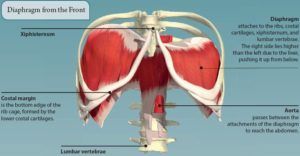The Diaphragm and Lower Back Pain?
Low back pain is a very common orthopedic condition that brings people to physical therapy. There are many factors that play into an individual’s back pain, making it one of the hardest areas of the body to treat. Recent literature has keyed in on breathing patterns and diaphragm dysfunction as a factor contributing to lower back pain.
Clinical Anatomy for Lower Back Pain
Typically, the diaphragm is talked about in relation to the pulmonary system. As the main muscle of inspiration, the diaphragm is important to the pulmonary system. More recently, the diaphragm has been referenced in orthopedic conditions, specifically low back pain. The link to low back pain is due to the diaphragms origins on lumbar vertebrae 1-3. When functioning properly, the diaphragm contributes to maintaining spinal stability and posture in the lumbar spine are important to lumbar mechanics.
The diaphragm has connections with the trunk flexors, extensors and pelvic floor muscles, all of which are possible contributors to lower back pain. These links highlight the idea of the body being a kinetic chain. When one link is not working properly, it can effect the other links it is connected to. If the diaphragm isn’t working properly, it can lead to problems down the kinetic chain, leading to lower back pain.

Physiology of the Diaphragm in Relation to Lower Back Pain
The diaphragm helps to stabilize the spine by increasing intra-abdominal pressure during balancing and loading tasks. During standing, intra-abdominal pressure works to stabilize the spine with very little unloading effect. During forward lifting tasks, intra-abdominal pressure creates an unloading moment, decreasing trunk muscle activity. When the spine is loaded, Problems with the diaphragm become prominent with tasks involving spinal loading.
Because the diaphragm’s role varies based on functional activity, proper recruitment of muscle fibers is important in spinal mechanics. The diaphragm demonstrates abnormal recruitment patterns during inhalation with postural movements in people with lower back pain. The diaphragm exhibits altered positions in these people which can exacerbate lower back pain. Lack of diaphragm activation can result in overactivity of lumbar paraspinal muscles causing hyperlordosis of the lumbar spine and/or anterior pelvic tilt causing pain in the lumbar region.
If you are having lower back pain, it is crucial for your Physical Therapist to evaluate diaphragmatic function during different postural activities. Learning how to control diaphragmatic function during postural activities can help to address one component of lower back pain!
Tips to Improve Diaphragm Function
- Assess your diaphragm activation
- While laying on your back, place your hand just below the diploid process. Sniff in through your nostrils and feel for muscle contraction under the hand on your belly
- Practice belly breathing
- Place your dominant hand on your diaphragm and your non-dominant hand on the chest.
- Breathe into your bottom hand — you are looking for a rise in your belly (NOT your chest)
- Exhale, allowing the belly to sink back down
- Once you master breathing laying down, try belly breathing in sitting and then standing.
- Bring awareness to breathing during lifting activities
- Inhale prior to lifting
- Exhale when performing the effort part of a task
- Ex. When performing a squat, inhale on the way down into the squat. Exhale when you push your legs into extension.
Conclusion
At Symmetry, we will provide you with a comprehensive physical therapy assessment to get to the root cause of your problem. Check out our Youtube channel for more tips and easy to follow exercises videos.
